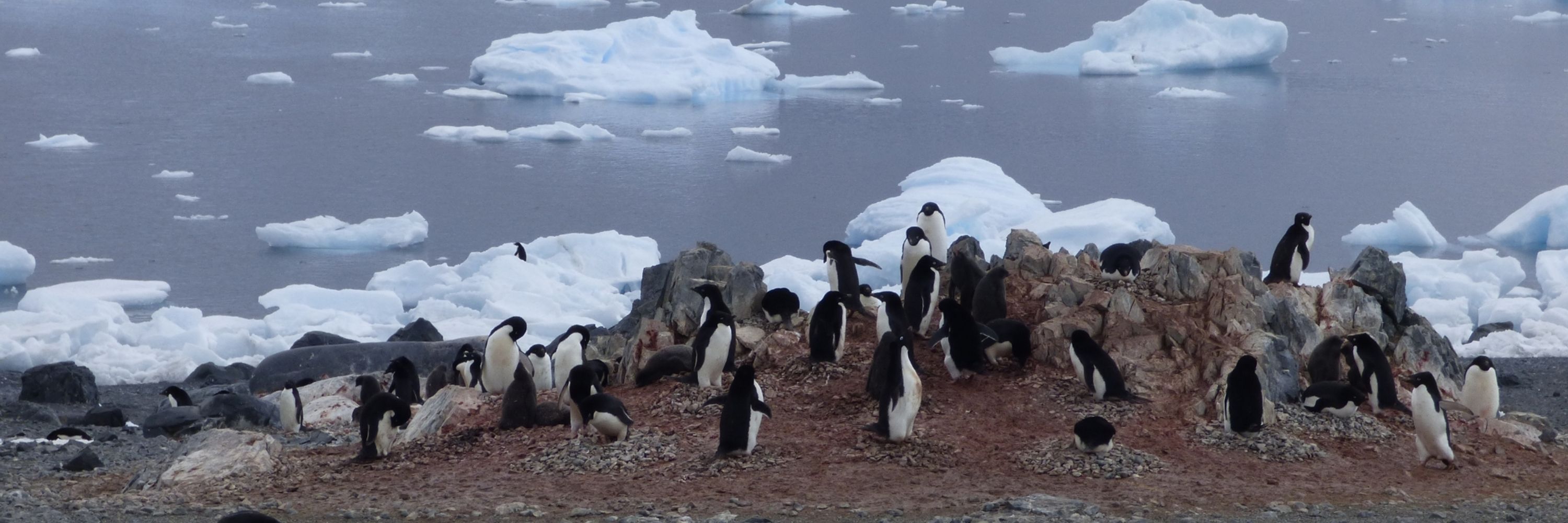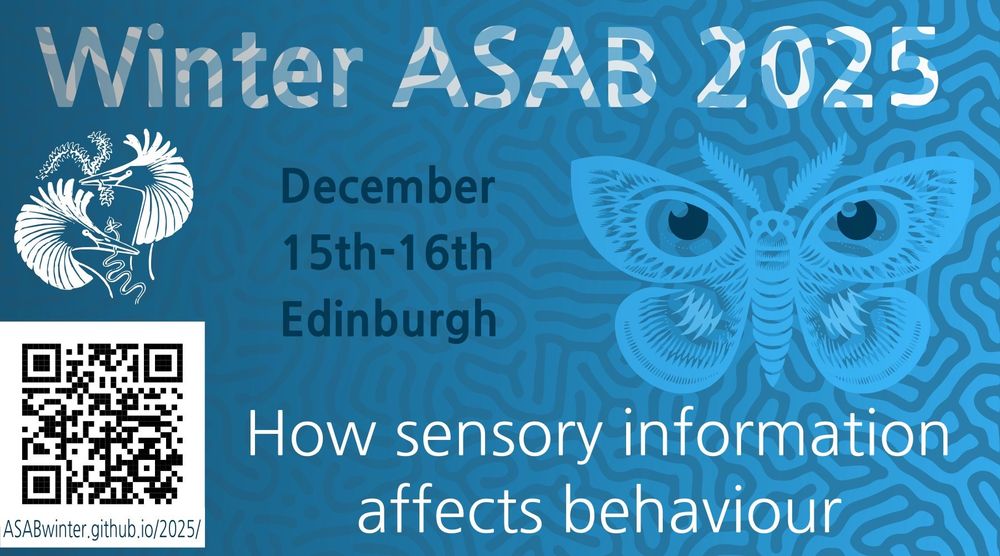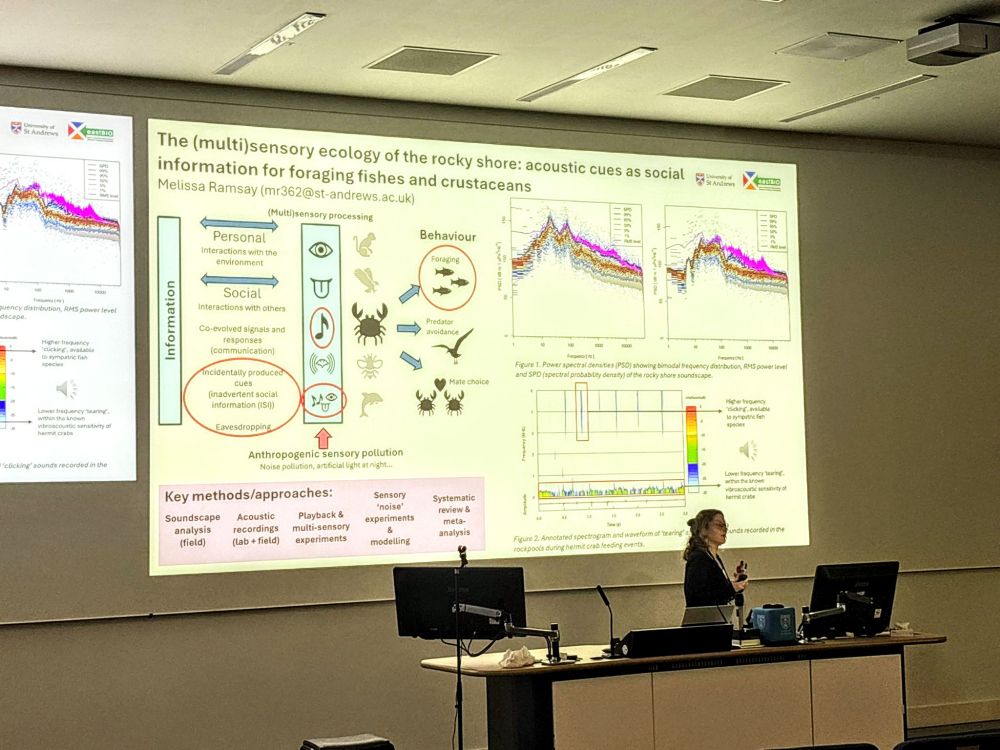
Animals Doing Stuff in Groups
@animalsdoingstuff.bsky.social
Hello, we are the Animals Doing Stuff in Groups lab, PI @mikemwebster.bsky.social at the University of St Andrews. We study animal behaviour and social interactions.
🐟(🐚🦀)🐧
https://sites.google.com/view/big-lab-webster/home?authuser=0
🐟(🐚🦀)🐧
https://sites.google.com/view/big-lab-webster/home?authuser=0
Reposted by Animals Doing Stuff in Groups
Our new paper offers an explanation for the universal law that "under carefully controlled conditions.... an animal behaves as it damn well pleases." We explore how stochastic mechanisms may play an underappreciated role in generating individuality. (1/7 🧵)
www.sciencedirect.com/science/arti...
www.sciencedirect.com/science/arti...

Playing dice with behavior: drivers of stochastic individuality
Animal behavior is often viewed as stemming from predictable genetic and environmental factors. However, despite our best attempts to control genetic …
www.sciencedirect.com
November 10, 2025 at 6:32 PM
Our new paper offers an explanation for the universal law that "under carefully controlled conditions.... an animal behaves as it damn well pleases." We explore how stochastic mechanisms may play an underappreciated role in generating individuality. (1/7 🧵)
www.sciencedirect.com/science/arti...
www.sciencedirect.com/science/arti...
Reposted by Animals Doing Stuff in Groups
#PhD position!
Comparing #foraging and #cognition in #hummingbirds and #bumblebees
Fieldwork in the Canadian Rockies, lab experiments at @newcastleuni.bsky.social, and ecological modelling at @uniofstandrews.bsky.social
Details (including my email) here: iapetus.ac.uk/studentships...
Comparing #foraging and #cognition in #hummingbirds and #bumblebees
Fieldwork in the Canadian Rockies, lab experiments at @newcastleuni.bsky.social, and ecological modelling at @uniofstandrews.bsky.social
Details (including my email) here: iapetus.ac.uk/studentships...

From preferences to pollination: do hummingbirds and bees differ in how they choose flowers?
iapetus.ac.uk
November 9, 2025 at 2:14 PM
#PhD position!
Comparing #foraging and #cognition in #hummingbirds and #bumblebees
Fieldwork in the Canadian Rockies, lab experiments at @newcastleuni.bsky.social, and ecological modelling at @uniofstandrews.bsky.social
Details (including my email) here: iapetus.ac.uk/studentships...
Comparing #foraging and #cognition in #hummingbirds and #bumblebees
Fieldwork in the Canadian Rockies, lab experiments at @newcastleuni.bsky.social, and ecological modelling at @uniofstandrews.bsky.social
Details (including my email) here: iapetus.ac.uk/studentships...
Reposted by Animals Doing Stuff in Groups
The more complex three or four component calls are social calls produced by the Soprano Pipistrelle to communicate with other bats. Great recordings by the students from St Andrews! Analysed using Kaleidoscope from @wildlifeacoustics.com
#acoustic #ecology #bats #echolocation #fieldwork
#acoustic #ecology #bats #echolocation #fieldwork
November 6, 2025 at 8:08 AM
The more complex three or four component calls are social calls produced by the Soprano Pipistrelle to communicate with other bats. Great recordings by the students from St Andrews! Analysed using Kaleidoscope from @wildlifeacoustics.com
#acoustic #ecology #bats #echolocation #fieldwork
#acoustic #ecology #bats #echolocation #fieldwork
Reposted by Animals Doing Stuff in Groups
The Pipistrelle is echolocating at about 55 kHz and has a wingspan of roughly 20cm, while the Free-tailed Bat is huge, with a wingspan of 45cm. It’s echolocating at a much lower frequency: 10-16 kHz, within the range of human hearing. @animalsdoingstuff.bsky.social
November 6, 2025 at 8:08 AM
The Pipistrelle is echolocating at about 55 kHz and has a wingspan of roughly 20cm, while the Free-tailed Bat is huge, with a wingspan of 45cm. It’s echolocating at a much lower frequency: 10-16 kHz, within the range of human hearing. @animalsdoingstuff.bsky.social
Reposted by Animals Doing Stuff in Groups
While on their field course with us, MSc students from the University of St Andrews carried out independent research projects. One group studied bat behaviour using ultrasonic recorders. Here, they’ve managed to record a Soprano Pipistrelle and a European Free-tailed Bat.
@mikemwebster.bsky.social
@mikemwebster.bsky.social
November 6, 2025 at 8:08 AM
While on their field course with us, MSc students from the University of St Andrews carried out independent research projects. One group studied bat behaviour using ultrasonic recorders. Here, they’ve managed to record a Soprano Pipistrelle and a European Free-tailed Bat.
@mikemwebster.bsky.social
@mikemwebster.bsky.social
Reposted by Animals Doing Stuff in Groups
Humans perceive but animals don’t: pitfalls in using plasticine models for assessing biotic interactions buff.ly/7hcLYXx | #ProcB #Ecology

October 26, 2025 at 3:01 PM
Humans perceive but animals don’t: pitfalls in using plasticine models for assessing biotic interactions buff.ly/7hcLYXx | #ProcB #Ecology
Check out this fascinating special edition of the Journal of Fish Biology @thefsbi.bsky.social focussed on how we study cognition in fishes- led by lab alumnus @nickarjones.bsky.social
🐟 Our special issue "Measuring Fish Cognition: Empirical-based Guidance for Designing Cognition Assays" is out! From acclimation protocols to automated tracking, these studies tackle a range of methodological issues. Check it out: tinyurl.com/vdprfbf4 #FishCognition #AnimalBehaviour

Special Issue: Measuring fish cognition: Empirical based guidance for designing cognition assays: Journal of Fish Biology: Vol 107, No 4
The <em>Journal of Fish Biology</em> is a leading international ichthyology journal, addressing all aspects of fish biology, their exploitation and importance to human society.
tinyurl.com
October 21, 2025 at 5:48 PM
Check out this fascinating special edition of the Journal of Fish Biology @thefsbi.bsky.social focussed on how we study cognition in fishes- led by lab alumnus @nickarjones.bsky.social
Reposted by Animals Doing Stuff in Groups
City lizards are more social. In a new paper in #BiologyLetters, social network analysis revealed that urban lizards have more social connections and stronger bonds than their non-urban counterparts. buff.ly/kqf2YfZ | #Behaviour #UrbanEcology

September 26, 2025 at 9:01 AM
City lizards are more social. In a new paper in #BiologyLetters, social network analysis revealed that urban lizards have more social connections and stronger bonds than their non-urban counterparts. buff.ly/kqf2YfZ | #Behaviour #UrbanEcology
Reposted by Animals Doing Stuff in Groups
super cool study found human artifacts in Bearded vulture nests, incl. "weaponry like a crossbow bolt and wooden lance, decorated sheep leather, and parts of a slingshot....a shoe made from twigs and grass is ~675-years-old." link to paper: doi.org/10.1002/ecy..... www.popsci.com/environment/... 🧪🌍🦉

Multi-generational vulture nests hold 700 years of human artifacts
Crossbow bolts, sandals, slingshots, and more.
www.popsci.com
October 3, 2025 at 1:06 PM
super cool study found human artifacts in Bearded vulture nests, incl. "weaponry like a crossbow bolt and wooden lance, decorated sheep leather, and parts of a slingshot....a shoe made from twigs and grass is ~675-years-old." link to paper: doi.org/10.1002/ecy..... www.popsci.com/environment/... 🧪🌍🦉
Reposted by Animals Doing Stuff in Groups
In a world bursting with colour, why go monochrome? I joined Tim Caro & Martin How on the BBC World Service’s Crowdscience to explore why some animals stand out in stark contrast. From 🦓🐼🐧 it turns out the answers aren’t always so black & white 😉
www.bbc.co.uk/sounds/play/...
www.bbc.co.uk/sounds/play/...

CrowdScience - Why are some animals black and white? - BBC Sounds
Why are zebras so stripy? Why do penguins wear tuxedos?
www.bbc.co.uk
October 3, 2025 at 8:22 PM
In a world bursting with colour, why go monochrome? I joined Tim Caro & Martin How on the BBC World Service’s Crowdscience to explore why some animals stand out in stark contrast. From 🦓🐼🐧 it turns out the answers aren’t always so black & white 😉
www.bbc.co.uk/sounds/play/...
www.bbc.co.uk/sounds/play/...
Reposted by Animals Doing Stuff in Groups
🆕 in the ESA Bulletin's Photo Gallery: A deep-sea fight between a fish & a sea lily, previously speculated but not actually observed, caught on camera and described in @ESAEcology's #TheScientificNaturalist series
See more 📸: doi.org/10.1002/bes2...
Read the study: doi.org/10.1002/ecy....
See more 📸: doi.org/10.1002/bes2...
Read the study: doi.org/10.1002/ecy....

May 16, 2025 at 5:09 PM
🆕 in the ESA Bulletin's Photo Gallery: A deep-sea fight between a fish & a sea lily, previously speculated but not actually observed, caught on camera and described in @ESAEcology's #TheScientificNaturalist series
See more 📸: doi.org/10.1002/bes2...
Read the study: doi.org/10.1002/ecy....
See more 📸: doi.org/10.1002/bes2...
Read the study: doi.org/10.1002/ecy....
Reposted by Animals Doing Stuff in Groups
Animal brains don’t think in a vacuum, they think in heatwaves & hypoxia, and around predators, parasites, and social groups. Our new review maps mechanisms, timescales, and gaps for understanding animal cognition in changing environments: authors.elsevier.com/a/1lau5Esvgs...


August 12, 2025 at 9:06 AM
Animal brains don’t think in a vacuum, they think in heatwaves & hypoxia, and around predators, parasites, and social groups. Our new review maps mechanisms, timescales, and gaps for understanding animal cognition in changing environments: authors.elsevier.com/a/1lau5Esvgs...
Reposted by Animals Doing Stuff in Groups
Join us for #ASABWinter2025 in Edinburgh Dec 15-16 🏴
Abstracts for posters/talks due Aug 29
More details here: asabwinter.github.io/2025/
Abstracts for posters/talks due Aug 29
More details here: asabwinter.github.io/2025/

July 29, 2025 at 5:07 PM
Join us for #ASABWinter2025 in Edinburgh Dec 15-16 🏴
Abstracts for posters/talks due Aug 29
More details here: asabwinter.github.io/2025/
Abstracts for posters/talks due Aug 29
More details here: asabwinter.github.io/2025/
Reposted by Animals Doing Stuff in Groups
Interesting new paper on color "rules" in terrestrial mammals, suggesting that Gloger's rule actually holds:
onlinelibrary.wiley.com/doi/10.1002/...
onlinelibrary.wiley.com/doi/10.1002/...

Gloger's Rule or Historical Conjecture? Tests in Mammals
Ecogeographical rules for animal coloration include Gloger's rule, which states that homeotherms are darker at lower latitudes; however, 19th-century naturalists observed that animals are more colour...
onlinelibrary.wiley.com
July 31, 2025 at 7:20 PM
Interesting new paper on color "rules" in terrestrial mammals, suggesting that Gloger's rule actually holds:
onlinelibrary.wiley.com/doi/10.1002/...
onlinelibrary.wiley.com/doi/10.1002/...
Reposted by Animals Doing Stuff in Groups
🔴New #trumpetfish content!🔴 This species is colour #polymorphic so we dove (pun intended) into how the relative abundance and saliency of each morph influences the #behaviour of their prey. Find out more via the link below! 🎺🐠
🔗 tinyurl.com/39vn5skp #behavioralecology
🔗 tinyurl.com/39vn5skp #behavioralecology

Antagonistic effects of predator color morph abundance and saliency on prey anti-predator responses
Predators can have different color morphs, but whether morph abundance or saliency is more influential in shaping antipredator behavior in prey remains unc
tinyurl.com
July 23, 2025 at 2:11 PM
🔴New #trumpetfish content!🔴 This species is colour #polymorphic so we dove (pun intended) into how the relative abundance and saliency of each morph influences the #behaviour of their prey. Find out more via the link below! 🎺🐠
🔗 tinyurl.com/39vn5skp #behavioralecology
🔗 tinyurl.com/39vn5skp #behavioralecology
Reposted by Animals Doing Stuff in Groups
Reposted by Animals Doing Stuff in Groups
Happy to share our new paper introducing the Animal Culture Database in Scientific Data: We’re putting together a resource consolidating primary research on cultural behaviors in wild animal populations and how they’re affected by human activity (1/5) www.nature.com/articles/s41...

Mapping nonhuman cultures with the Animal Culture Database - Scientific Data
Scientific Data - Mapping nonhuman cultures with the Animal Culture Database
www.nature.com
June 22, 2025 at 11:16 PM
Happy to share our new paper introducing the Animal Culture Database in Scientific Data: We’re putting together a resource consolidating primary research on cultural behaviors in wild animal populations and how they’re affected by human activity (1/5) www.nature.com/articles/s41...
Reposted by Animals Doing Stuff in Groups
This is how it looks when a Sea Anemone runs away from a Starfish.
July 19, 2025 at 3:52 PM
This is how it looks when a Sea Anemone runs away from a Starfish.
Reposted by Animals Doing Stuff in Groups
The first papers from our special collection on vocal communication in corvids are now live. Most are still under review, stay tuned for more updates as they’re published! link.springer.com/collections/...
Vocal communication in corvids
In the field of vocal communication, research has mostly focussed on birds because of their vocal learning capacity and non-human primates due to their ...
link.springer.com
July 18, 2025 at 8:47 AM
The first papers from our special collection on vocal communication in corvids are now live. Most are still under review, stay tuned for more updates as they’re published! link.springer.com/collections/...
Reposted by Animals Doing Stuff in Groups
A little moon jelly at the rockpools today🪼 @animalsdoingstuff.bsky.social
July 16, 2025 at 5:40 PM
A little moon jelly at the rockpools today🪼 @animalsdoingstuff.bsky.social
Reposted by Animals Doing Stuff in Groups
Fish are smarter than you think! They can distinguish and remember individuals, navigate with mental maps, cooperate and communicate with one another, build complex structures, use tools, and keep track of quantities.

Fish Are Smarter Than You Think
Researchers developed a way to run tests on fish learning and memory in the animals' natural environments. The results may reveal that fish are smarter than previously assumed.
www.psychologytoday.com
July 10, 2025 at 12:08 PM
Fish are smarter than you think! They can distinguish and remember individuals, navigate with mental maps, cooperate and communicate with one another, build complex structures, use tools, and keep track of quantities.
Reposted by Animals Doing Stuff in Groups
I really enjoyed presenting some preliminary results from my PhD work at the St Andrews Biology PGR conference today! It was great to see all the cool work coming out of our community as well 🦀🐟🔊 (thanks to @mikemwebster.bsky.social and @lrendell.bsky.social as always)

June 11, 2025 at 6:14 PM
I really enjoyed presenting some preliminary results from my PhD work at the St Andrews Biology PGR conference today! It was great to see all the cool work coming out of our community as well 🦀🐟🔊 (thanks to @mikemwebster.bsky.social and @lrendell.bsky.social as always)
Reposted by Animals Doing Stuff in Groups
Another bright morning at the rocky shore with some members of 'Team Fish'🐟🦀☀️🌊 @animalsdoingstuff.bsky.social



May 14, 2025 at 9:31 PM
Another bright morning at the rocky shore with some members of 'Team Fish'🐟🦀☀️🌊 @animalsdoingstuff.bsky.social
Reposted by Animals Doing Stuff in Groups
A very eventful five seconds 🦀🐟🫧
June 5, 2025 at 5:47 PM
A very eventful five seconds 🦀🐟🫧

